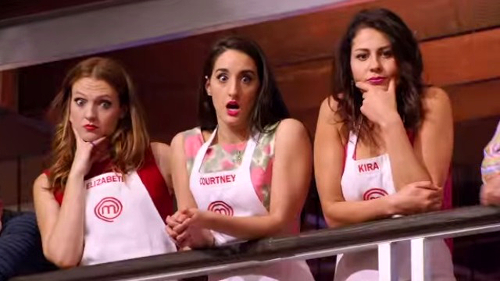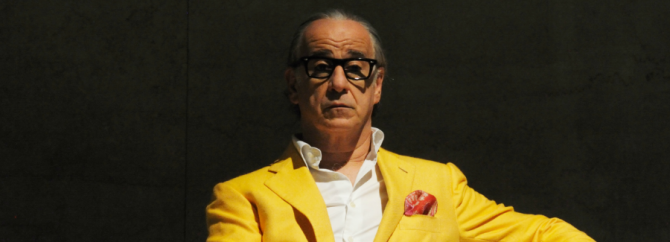Being a feminist can be hard, like when it interferes with my god-given right to irrationally hate reality TV contestants. The “love-to-hate” feeling is basically the entire point of watching reality television. There is no room for guilty consciences. And yet, this past season of MasterChef USA forced me and my partner to wrestle with why we were hating on our least favorite contestants, because the obvious answer was that we’re sexist jerks.

Examining my sexist reaction to this season of MasterChef made me realize the pervasive role of gender expectations in the series. MasterChef distinguishes itself from other cooking reality competition shows by focusing on “home cooks” without any formal training. Between traditional gendered work divisions regarding who cooks at home (somehow persisting even in the era of the “foodie”), and the rampant sexism of the professional culinary industry, the line between “home cooks” and “chefs” is undeniably gendered.
But the MasterChef producers have done their best to obscure this dynamic: there are a roughly equal number of male and female contestants at the start of each series; and over five seasons, the collective male/female breakdown between the top ten, top five, and top three contestants stays close to 50-50 (26-24 women-to-men in the top ten, 12-13 in the top five, and 8-7 in the top three). This steady equality might be the result of some producer meddling, but MasterChef contestants are never explicitly separated into gender ranks (whereas on the long-running Hell’s Kitchen, also hosted by Gordon Ramsay, has a “boys team” and “girls team” for the bulk of each season, but not necessarily a steady rate of loss from each side as one team is generally made safe from elimination in each episode).

This hasn’t stopped the MasterChef contestants from breaking into gendered ranks. A recurring theme is for male contestants to look down on creating desserts and baking as lesser talents, and to dismiss their female competitors’ successes in those challenges. The quintessential example is the first-season elimination of would-be front-runner Sharone, a cocksure Finance Dude, by Whitney, the Personification of Sugar and Spice and Everything Nice, in a challenge to bake a chocolate souffle. Sharone’s attempts to “elevate the dish” (the second most liver-damaging item on the MasterChef drinking game, after Gordon Ramsay using “most amazing” to describe an ingredient) with sea salt backfired, and Whitney’s straightforward but perfectly executed souffle carried her forward to become the first US MasterChef winner. In his exit interview, Sharone expressed lament that “the pastry princess” had the chance to knock him from the competition in a baking challenge.

The High Cuisine Pretenders of MasterChef, who scoff at “rustic” challenges to make comfort food and awkwardly attempt molecular gastronomy, have been nearly exclusively male contestants. They are not there to be crowned “the best home cook in America,” they are there to be discovered as culinary geniuses. These guys usually flame out before the top 10. But notably, even the more grounded male competitors usually say they will use their winnings to open a restaurant, while the women in the competition often focus on the opportunity of the winner’s published cookbook, and see the $250,000 prize as a financial break rather than a seed investment.
The “this will change my life” reality TV cliche applies neatly to the MasterChef Season 5 HitchDied Hateoff. My most-hated contestant, season-winner Courtney, leaned on this trope with all her weight. My husband’s most-hated contestant, Leslie (second-runner up), was notably privileged and “didn’t need” the winnings.

But this is not just a matter of haves and have-nots, because of what Courtney and Leslie each do for a living. Leslie is a stay-at-home father with a very successful wife. Or, as fellow contestant Cutter put it, “an ex-beautician house bitch.”
Courtney, per her talking head caption, is an aerial dancer. But in her own words, she frames her work as the desperate choice of a woman struggling to make ends meet: “I’ve done things I’m not proud of. No being able to pay my rent, I made the difficult, embarrassing decision to work in a gentleman’s club.”

And so the HitchDied Hate-off for MasterChef Season 5 became mired in dueling accusations of antifeminism. Collin would insist it is not that Leslie is a metrosexual stay-at-home dad that makes him unlikable, but that he’s haughty phony. I would insist that I don’t judge Courtney for her job, just her attitude about it. (Neither of us could get away with saying we hate them for being untalented chefs or cruel competitors, they both clearly deserved their success on the show.)

But I also made fun of Courtney for her aggressively performed femininity (her kitchen uniform is poufy dresses and towering heels) and breathy baby voice, and I can’t deny the sexism in finding these “girly” traits annoying. Especially because I’m a big fan of poufy dresses myself, and might wear towering heels if I weren’t so clumsy. (I thought maybe the heels were to “keep in shape for work,” but aerial dancers perform barefoot, right?) MasterChef‘s narrative didn’t let me feel alone in my hate: other female contestants (including runner-up Elizabeth) complained in their talking heads that Courtney benefited from favoritism from the judges, something we never heard when former Miss Delaware Jennifer came out on top of season 2. So why is Courtney so specially hate-able? Do we hate her because she’s beautiful? Do we hate her because she does sex work? Do we hate her because she’s a girly girl? Is there some other answer here that doesn’t make me a bad feminist for hating Courtney?

And is my internalized misogyny to blame, or the MasterChef producers for exploiting it? I couldn’t tell you what any of the other contestants in four seasons of MasterChef wore on their feet, because they didn’t cut ShoeCam every time they walked their dish to the judges. Judge Joe Bastianich bizarrely wears running shoes with his super fancy suits, and I think that took me three seasons to notice. But we saw more of Courtney’s shoes than we saw of some contestant’s faces. It seemed like a sneaky way for the producers to remind us “Courtney is a stripper!” in between her self-shaming confessions, because reality TV producers would see a woman being “saved” from sex work the greatest possible form of the “this will change my life” narrative.
So it goes. Courtney gets her trophy and cookbook, the producers get their “provocative” storyline, Leslie probably has enough money to do whatever he wants anyway, and the HitchDieds will continue irrationally hating reality show contestants despite our feminist misgivings.
Have you ever hated-to-hate a reality TV contestant? Have you caught yourself hating people on TV for sexist reasons?
Robin Hitchcock is an American writer living in Cape Town and slightly-better-than-mediocre home cook.















